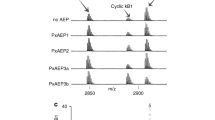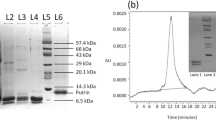Abstract
The cyclic peptide sunflower trypsin inhibitor 1 (SFTI-1) blocks trypsin and is a promising drug lead and protein engineering scaffold. We show that SFTI-1 and the newfound SFT-L1 are buried within PawS1 and PawS2, precursors for seed storage protein albumins. Proalbumins are matured by asparaginyl endopeptidase, which we show is required to liberate both ends of SFTI-1 as well as to mature PawS1 albumin. Thus, these peptides emerge from within an albumin precursor by the action of albumin's own processing enzyme.


Similar content being viewed by others
References
Luckett, S. et al. J. Mol. Biol. 290, 525–533 (1999).
Korsinczky, M.L. et al. J. Mol. Biol. 311, 579–591 (2001).
Daly, N.L. et al. J. Biol. Chem. 281, 23668–23675 (2006).
Long, Y.Q. et al. Bioorg. Med. Chem. Lett. 11, 2515–2519 (2001).
Swedberg, J.E. et al. Chem. Biol. 16, 633–643 (2009).
Mulvenna, J.P., Foley, F.M. & Craik, D.J. J. Biol. Chem. 280, 32245–32253 (2005).
Shewry, P. & Pandya, M. The 2S Albumin Storage Proteins. in Seed Proteins (eds. Shewry, P. & Casey, R.) 883 (Kluwer, Dordrecht, 1999).
Panero, J. XXVI. Tribe Heliantheae. in Flowering Plants, Eudicots: Asterales Vol. 8 (eds. Kadereit, J. & Jeffrey, C.) 635 (Springer, New York, 2007).
Hara-Hishimura, I., Takeuchi, Y., Inoue, K. & Nishimura, M. Plant J. 4, 793–800 (1993).
Gruis, D., Schulze, J. & Jung, R. Plant Cell 16, 270–290 (2004).
Shimada, T. et al. J. Biol. Chem. 278, 32292–32299 (2003).
Hiraiwa, N., Nishimura, M. & Hara-Nishimura, I. FEBS Lett. 447, 213–216 (1999).
Kuroyanagi, M. et al. J. Biol. Chem. 280, 32914–32920 (2005).
Saska, I. et al. J. Biol. Chem. 282, 29721–29728 (2007).
Jennings, C. et al. Proc. Natl. Acad. Sci. USA 98, 10614–10619 (2001).
Gillon, A.D. et al. Plant J. 53, 505–515 (2008).
Robinson, J.A. Acc. Chem. Res. 41, 1278–1288 (2008).
D'Hondt, K. et al. J. Biol. Chem. 268, 20884–20891 (1993).
Hiraiwa, N., Kondo, M., Nishimura, M. & Hara-Nishimura, I. Eur. J. Biochem. 246, 133–141 (1997).
Otegui, M.S . et al. Plant Cell 18, 2567–2581 (2006).
Autelitano, D.J. et al. Drug Discov. Today 11, 306–314 (2006).
Hartl, M., Giri, A.P., Kaur, H. & Baldwin, I.T. Plant Cell, 22, 4158–4175 (2010).
Acknowledgements
The authors thank staff at the Arizona Genomics Institute (University of Arizona) for providing Helianthus cDNA clones, the Compositae Genome Project website (http://cgpdb.ucdavis.edu/) that was supported by the United States Department of Agriculture Initiative for Future Agriculture and Food Systems program and National Science Foundation Plant Genome Program for EST data, S. Dillon (Australian Plant Genetic Resource Information Service) for Helianthus seeds, I. Hara-Nishimura (University of Kyoto) for aep null seeds, A. Argyros for technical assistance, H. Schirra (University of Queensland) for providing the structural image used in Supplementary Figure 1 as well as R. Jung, M. Anderson, D. Ortiz-Barrientos and S. Balasubramanian for comments. D.J.C. is a National Health and Medical Research Council Professorial Fellow. J.S.M. is an Australian Research Council Queen Elizabeth II Fellow (DP0879133) and The John S. Mattick Fellow. N.L.D. is a Queensland Smart State Fellow.
Author information
Authors and Affiliations
Contributions
J.S.M., N.L.D. and D.J.C. conceived the study; J.S.M., A.H.C., A.G.E. and E.J.M. performed the experiments, N.L.D. obtained the SFT-L1 structure; M.L.C. and A.J. performed MS studies; J.S.M., N.L.D. and M.L.C. analyzed the data; J.S.M. and D.J.C. wrote the paper.
Corresponding authors
Ethics declarations
Competing interests
The authors declare no competing financial interests.
Supplementary information
Supplementary Text and Figures
Supplementary Methods, Supplementary Figures 1–13 and Supplementary Tables 1–8 (PDF 6835 kb)
Rights and permissions
About this article
Cite this article
Mylne, J., Colgrave, M., Daly, N. et al. Albumins and their processing machinery are hijacked for cyclic peptides in sunflower. Nat Chem Biol 7, 257–259 (2011). https://doi.org/10.1038/nchembio.542
Received:
Accepted:
Published:
Issue Date:
DOI: https://doi.org/10.1038/nchembio.542
- Springer Nature America, Inc.
This article is cited by
-
Discovery and biosynthesis of cyclic plant peptides via autocatalytic cyclases
Nature Chemical Biology (2022)
-
Transcriptomic profiling of the medicinal plant Clitoria ternatea: identification of potential genes in cyclotide biosynthesis
Scientific Reports (2020)
-
A bifunctional asparaginyl endopeptidase efficiently catalyzes both cleavage and cyclization of cyclic trypsin inhibitors
Nature Communications (2020)
-
Stabilization of Proteins by Covalent Cyclization
Biotechnology and Bioprocess Engineering (2019)
-
Progress toward sourcing plants for new bioconjugation tools: a screening evaluation of a model peptide ligase using a synthetic precursor
3 Biotech (2019)





